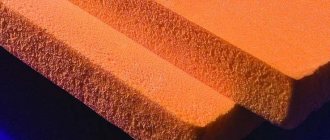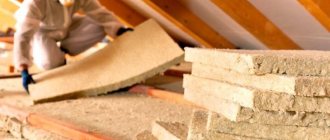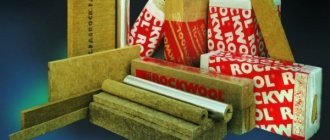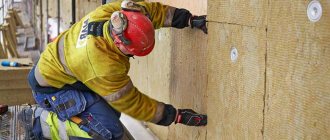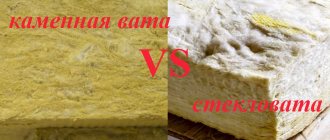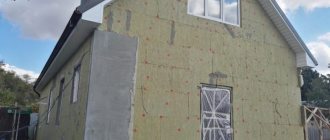Stone wool, mineral wool, basalt wool are the names of thermal insulation material with a fibrous structure obtained from molten rocks. In the form of mats, rolls, and molded products, it is widely used as insulation in the construction and renovation of buildings. Is this material safe? How to properly attract it in construction and repair without harm to health?
It should be noted that builders use the term “mineral wool” to refer to different materials: stone wool, glass wool, slag wool.
- Glass wool is mineral wool made from molten broken glass and waste from the glass industry.
- Rock wool is mineral wool made primarily from molten rocks.
- Slag wool is mineral wool made from molten blast furnace slag.
The safest of them is stone wool.
Properties of mineral wool
Due to the great demand for this material, there are many manufacturers of mineral wool. In production, each manufacturer can endow its products with different properties. High-quality mineral wool has low thermal conductivity, due to which it can be used for insulation of walls and roofs. At the same time, there are lines of materials in the production of which special technologies are used. These products differ in their characteristics from the standard ones.
There is an unconfirmed opinion among users that mold forms on mineral wool when it comes into contact with water due to rotting of the material. Users also talk about the presence of harmful substances released into the air by mineral wool. If they come into contact with the skin and mucous membranes, they are harmful to health. Let's look at the myths and facts about mineral wool.
Basalt and human lungs
This material is solidified magma. Basalt is usually located on the surface of the earth. Basalt contains more than one rock.
According to statistics, many people now believe that basalt causes significant harm to the human respiratory system. This is quite reasonable in the case of cheap materials created without following specifications.
Ecowool with a normal strength index is not capable of causing harm to humans. In the same way, basalt wool cannot have any effect on the human body if it is located outside a residential area, for example, on the street.
This is due to the fact that the air outside is much cleaner than indoors. The only option in which harm to a person’s lungs will occur is if he actively breathes air in which there are many particles of basalt insulation board.
In many cases of lung diseases, people have had contact with: asbestos and mineral wool particles.
From a scientific point of view, such diseases arise due to the fact that small but sharp particles enter the human respiratory tract. As a result, they accumulate in the lungs, causing various damage to the membranes. In many cases, this results in serious chronic diseases.
Modern basalt insulation materials have impeccable characteristics. As a result, the fibers do not reach the eyes, lungs, or the body as a whole. Product certification is also of great importance.
Certified basalt insulation
Myth No. 1. Harmful from contact with moisture
Let's start with a justified myth that has a lot of truth in it. This applies to heat insulators that are produced using outdated technologies (use of glass wool). A negative reaction of mineral wool to contact with moisture leads to the accumulation of liquid with the further formation of mold. At the same time, it is not the cotton wool itself that is harmful to health, but the mold, which weakens the immune system and causes allergic reactions and inflammatory processes in the respiratory system. Also, contact with mold can cause skin, cardiovascular and central nervous system diseases.
To prevent the risk of exposure to mold on the body, it is recommended to simply choose high-quality building materials. When choosing, pay attention to heat insulators with a minimum water absorption coefficient. Even at high levels of humidity, such material does not absorb it, which eliminates the risk of mold.
Myth No. 2. Harm from burning
There are many rumors about the dangers of various insulating building materials from exposure to fire, and they have been spreading for quite a long time. For some time, users seriously believed that even burning laminated veneer lumber could have a negative impact on health, since chemical compounds are used in its production. Let’s not talk about the fact that by nature, when burning, any materials can emit harmful gases. One has only to note that when burned, mineral wool is absolutely harmless. Everything is very simple. Mineral wool does not burn. Modern building materials are produced on a basalt basis. As we know, basalt is a stone, which is why the material is also called stone wool. The stone does not support combustion processes, as well as its derivatives.
Research confirms this. Even under a gas burner aimed at the roll, the insulation may slightly change color and become charred, and even then only with direct and prolonged contact with the flame. If we talk about fires and destruction, they will not happen. Therefore, the myth that mineral wool releases harmful substances when burned is untrue.
Evaporation
In addition to the above-described problems associated with basalt fiber, ecowool contains resins. These resins are composed of various chemical compounds, including phenol and formaldehyde derivatives. It is due to these components that the fibers are bonded to each other.
Each such compound poses a great threat to human health.
Of course, these compounds are completely harmless if the highest quality raw materials were used during manufacturing and all requirements for the production of basalt insulation were followed.
In properly manufactured insulation, all components are bonded with phenol-formaldehyde resins. Only in this state are they absolutely harmless.
Materials manufactured in violation of the prescribed order may contain additional impurities. These impurities can cause various lung diseases (due to vapors) and skin irritations.
Myth No. 3. Thermal calculations
Experts say that when working on wall insulation, special calculations are required. Without experience, as well as the participation of specialized companies, these calculations are impossible. It is not surprising that the services of such specialists are expensive. In fact, this is not at all necessary. Over more than 50 years of production, mineral wool manufacturing companies classify materials based on shape, brand, and thickness. You can get advice from sellers who will give accurate recommendations. Thus, the need to carry out thermal engineering calculations is nothing more than a myth.
Myth No. 4. Harmful emissions
This myth is the most popular about building materials in general. For this reason, mineral wool simply cannot be ignored. No matter what kind of insulation is used in a particular case, you will hear about the harm it can cause to the environment. In fact, some thermal insulators are actually harmful. If the manufacturer uses low-quality materials with chemical additives, then such heat insulators can be harmful. But mineral wool is a material with which things are different. It is produced using unique technology; even despite the use of various additives, the products are environmentally friendly. The percentage of phenol resins used in production is so small that, despite all their harm, they are not capable of causing harm to health. The content of these substances in mineral wool is 1-2%. Well-known manufacturers go even further and do not use phenol resins. In such building materials, bitumen binders or derivatives are used.
What is the material
To figure out whether stone wool is harmful to human health, let's figure out what it is and what it is made of. So, the material includes the following components:
- Fibers (the basis of insulation). Obtained by melting rocks. Most often, basalt is used for these purposes - an absolutely safe raw material, which is used even in medicine. True, sometimes cotton wool is made from melted blast furnace slag. But, recently it is very rare to find this insulation on sale;
- Binder. Manufacturers form slabs or rolls from mineral fibers. To ensure a stable form of thermal insulation, the fibers are glued together using resin;
- Impregnations. To improve certain qualities of the material, it is treated with all kinds of compounds.
The photo shows the structure of stone wool
Thus, this insulation has a fibrous structure. Most of the volume is occupied by air and fibers obtained from natural materials.
Myth No. 5. Dust
Does mineral wool produce dust? They say that it penetrates the respiratory system, which causes health problems. However, this is only relevant if glass wool is used in production. Today, heat insulators are made on a basalt basis. Fiberglass-based material can indeed crumble as a result of mechanical stress. Dust that settles on the skin and in the lungs damages vision, causes allergies and problems with the respiratory system.
Basalt heat insulators do not have these disadvantages. During operation, the material does not crumble, and the dust generated in it is as harmful as ordinary indoor dust. Considering that the heat insulator is often hidden behind the finishing material, dust does not cause any harm to health. With high-quality insulation, the risk of dust being released into the air is almost eliminated.
Which facades using basalt wool pose the greatest threat?
Stone wool can cause maximum harm to humans if it is used to insulate ventilated facades. This use of basalt wool minimizes heat loss in the cold season, and in the summer, on the contrary, maintains coolness.
When installing such facades, it is necessary to provide a gap between the wall and the heat insulator to ensure not only the ventilation process, but also to remove excess moisture. In this regard, over time, the fibers turn into dust, which, thanks to drafts and ventilation, spreads throughout the room.
In addition, irritation of the mucous membrane of the eye, respiratory tract and skin occurs, allergies and bronchial asthma may occur. Such harm caused by stone wool is due to the spread of microparticles, which in structure resemble small needles. When you inhale, they easily enter the lungs, but when you inhale, they are no longer removed from the body. And over time, accumulated microelements are a provoking substance for the development of certain diseases.
Myth No. 6. Environmental friendliness
The quality of modern building materials plays an important role. In view of the increase in diseases of the respiratory system, this is not surprising. However, upon careful study of the composition of the material, as well as after research, scientists found that phenol-formaldehyde, which is contained in mineral wool, does not pose the danger that they say. According to experts, there are more harmful substances in urban air than in the insulation, which is hidden behind the skin and additionally treated with special impregnations.
Myth No. 7. Harm during installation
Another fashionable myth is the assertion that basalt material causes damage to health specifically during the installation process. This myth is connected with the past and appeared in the early USSR. At that time, building materials were scarce, and it was not easy to get new products. Because of this, when purchasing, people received far from the quality they dreamed of. Mineral wool was rarely used at all, since it was practically not represented on the market. Fiberglass wool was made from industrial waste and was indeed potentially harmful. This is due to the unusual structure, as well as broken glass as the main raw material. It was ground, melted and special fibers were created.
Installation of such heat insulators cannot be carried out without protective equipment. It is laid under the influence of physical force, due to which bending loads are quite natural. The powder is practically invisible, so microparticles are released into the air. As a result of contact with the surface, it irritates the mucous membrane. Particularly when working with fiberglass wool, eye protection must be provided. Moreover, in the case of stone mineral wool, the material is devoid of all these disadvantages, so the myth is only partly true when it comes to materials that are produced on the basis of broken glass.
Is mineral wool harmful to health?
This heat insulator causes a lot of controversy and discussion. The danger of mineral wool has been exaggerated, while the heat insulator has ardent opponents who claim the opposite. Often negative opinions arise against the background of rumors or examples of friends who were unlucky enough to choose low-quality material. Manufacturers take into account that in the process of choosing products, the buyer takes into account not only thermal insulation properties, but also cost. Important characteristics also include non-flammability, environmental friendliness, moisture and vapor resistance.
To prevent the destructive effects of phenol and formaldehyde, it is recommended to choose materials with certificates. If the manufacturer follows the production technology, and all stages are taken into account when installing the heat insulator, you can protect yourself from the harm that is being emphasized. How to minimize harm from mineral wool? Use protective equipment. We are talking about gloves, glasses, a respirator, and long sleeves. Even if you come into contact with mineral wool, you can minimize its harm.
Application
Due to its excellent fire-resistant characteristics and heat-saving properties, mineral wools are used in construction for the construction of objects for almost any purpose, for laying/installing utility networks/systems, and assembling technological equipment; as well as in the manufacture of various products where the technical parameters of these products are in demand.
On this topic ▼
Fire safety during construction
Buildings, private houses, baths
Application area:
- For the production of fire-resistant insulation materials.
- For insulation, and often at the same time fire protection of ceilings, floors, roofs, technical, attic floors; facades, basements, attics of buildings.
- As a heat-insulating filling of cavities in brickwork; joints, gaps, cracks between reinforced concrete structures.
- For thermal insulation, preventing freezing of pipeline networks, technological communications of populated areas, industrial and warehouse facilities.
- As carriers of catalysts, filters for the purification of high-temperature gases, including acting as fire arresters for flammable gas mixtures.
- In the production of various products - from pipe products to vehicle brake pads as a reinforcing, heat-insulating base.
- For reinforcing refractory (fire-resistant) concrete.
- For constructive fire protection of load-bearing and enclosing building structures made of wood, metal, reinforced concrete; ducts of transit air ducts of ventilation units; exhaust chimneys, shafts of smoke removal systems.
- For thermal insulation, fire protection of pipes, fireplace chimneys, stoves.
- As a fire-resistant, heat-impervious protective coating, lining for combustible waste disposal furnaces; steam boilers, gas turbines of thermal power engineering facilities.
- For thermal protection of metallurgical furnaces, technological installations for oil refining, gas condensate.
- As a binder in the production of fire-resistant coatings, pastes, fire-retardant plasters.
- For thermal insulation of containers and tanks with compressed and liquefied gases.
- For filling the internal space of fire gates, partitions, hatches, doors.
- In heat/sound insulation of engine compartments, engine rooms, generator rooms of automobile, railway transport, sea and river vessels.


